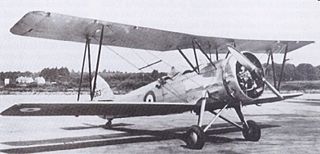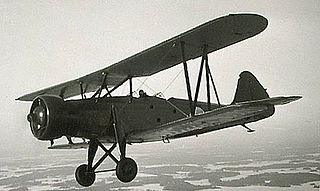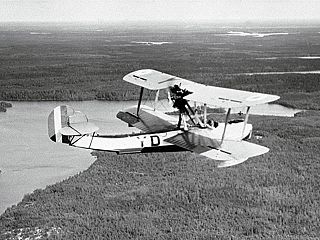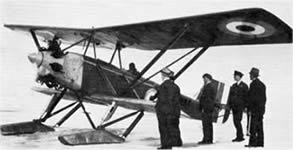
The Supermarine Stranraer is a flying boat designed and built by the British Supermarine Aviation Works company at Woolston, Southampton. It was developed during the 1930s on behalf of its principal operator, the Royal Air Force (RAF). It was the RAF's last and fastest biplane flying boat.

The Blackburn Shark was a carrier-borne torpedo bomber designed and built by the British aviation manufacturer Blackburn Aircraft. It was originally known as the Blackburn T.S.R., standing for "torpedo-spotter-reconnaissance", in reference to its intended roles. The Shark was the last of Blackburn's biplane torpedo bombers.

The Avro 618 Ten or X was a passenger transport aircraft of the 1930s. It was a licensed version by Avro of the Fokker F.VIIB/3m.

The Avro 626 is a single-engined British biplane trainer aircraft produced by Avro during the (1918-1939) inter-war period.

The Avro Type 621 Tutor is a two-seat British radial-engined biplane from the interwar period. It was a simple but rugged basic trainer that was used by the Royal Air Force as well as many other air arms worldwide.

The VL Tuisku was a Finnish trainer aircraft designed in the 1930s. It was a two-seat, single-engined biplane with a welded steel framework, covered with fabric. 30 were produced for the Finnish Air Force and served from 1935 to 1949.

The Canadian Vickers Vedette was the first aircraft designed and built in Canada to meet a specification for Canadian conditions. It was a single-engine biplane flying boat purchased to meet a Royal Canadian Air Force (RCAF) demand for a smaller aircraft than the Vickers Viking with a much greater rate of climb, to be suitable for forestry survey and fire protection work. The type went on to have a long and distinguished career in civil operations in Canada. Most of the topographical maps in use in Canada today are based on photos taken from these aircraft.

The Westland Wapiti was a British two-seat general-purpose military single-engined biplane of the 1920s. It was designed and built by Westland Aircraft Works to replace the Airco DH.9A in Royal Air Force service.

The Canadian Vickers Varuna was a Canadian flying boat of the 1920s built by Canadian Vickers as a twin-engined, unequal-span biplane, with a wooden hull and steel tube structure.

The Canadian Vickers Vanessa was a Canadian biplane transport floatplane of the 1920s evaluated by the Royal Canadian Air Force (RCAF) and used briefly for delivering air-mail.

The Armstrong Whitworth Atlas was a British single-engine biplane designed and built by Armstrong Whitworth Aircraft. It served as an army co-operation aircraft for the Royal Air Force (RAF) in the 1920s and 1930s. It was the first purpose-designed aircraft of the army co-operation type to serve with the RAF.

The Avro Type 584 Avocet was a British single-engined naval fighter prototype, designed and built by Avro. While the Avocet was not built in numbers, one of the prototypes was used as a seaplane trainer for the Royal Air Force's (RAF) High Speed Flight.
The Avro 636 was a single-engined British fighter-trainer built by Avro in the mid-1930s. Four were built for the Irish Air Corps.

The Blackburn F.2 Lincock was a British single-seat lightweight fighter produced by Blackburn Aircraft Limited.

The de Havilland DH.75 Hawk Moth was a 1920s British four-seat cabin monoplane built by de Havilland at Stag Lane Aerodrome, Edgware.

The Koolhoven F.K.51 was a 1930s Dutch two-seat basic training biplane built by the Koolhoven Company.

The Fairchild FC-1 and its derivatives were a family of light, single-engine, high-wing utility monoplanes produced in the United States in the 1920s and 1930s. The aircraft was originally designed to provide a camera platform for Sherman Fairchild's aerial photography and survey business, Fairchild Aerial Surveys.

The Northrop Delta was an American single-engined passenger transport aircraft of the 1930s. Closely related to Northrop's Gamma mail plane, 13 were produced by the Northrop Corporation, followed by 19 aircraft built under license by Canadian Vickers Limited.

The Canadian Vickers Vista was a Canadian-designed single-seat flying boat.

The Canadian Vickers Vigil was a single-seat patrol aircraft designed to meet a Royal Canadian Air Force requirement for a forest fire patrol aircraft.



















